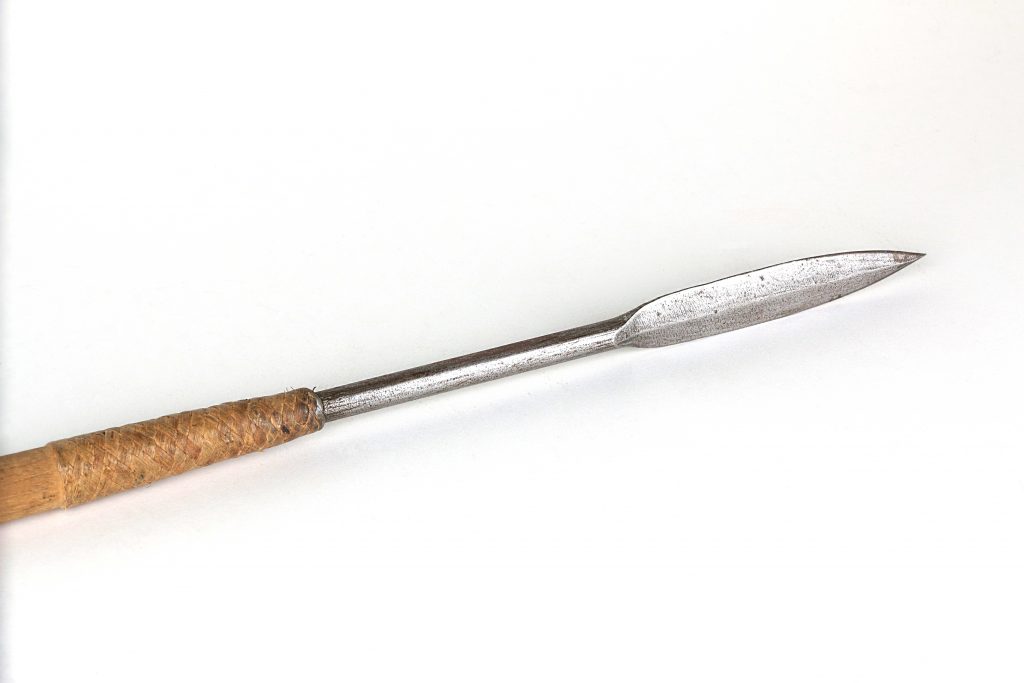
Listen to the pronunciation
| What is this? | Spear |
| isiZulu Name | Isiphapha |
| isiXhosa Name | Not yet documented. |
| English Name | Spear |
| Which cultural group created this? | Zulu |
| Who made this? | Not yet documented. |
| When was it made? | Not yet documented. |
| Where was it made? | Probably KwaZulu-Natal |
| Measurements | Not yet documented. |
| How was it made and what is it made of? | Wooden shaft, metal spearhead, vegetal (?) twine. |
| What colour is it? | Shaft: light brown Spearhead: silver Twine: light brown |
| What sound does it make? | Not yet documented. |
| Physical description | Long spear. Shaft made of wood and spearhead made of metal. Both parts come together and are tightened by twine (vegetal?). |
| Where is it now? | Iziko Museum, Cape Town, South Africa Museum ID: SAM 4935 |
| How did it get there? | Not yet documented. |
| Why is it important? | Spear made of wood (Kalinga?) and metal. The shaft was plated with glass, and the spearhead inserted in the shaft with an opening. The tip may contain poison (from the Black Mamba) since it was used for hunting. Sometimes, the spearhead is made with an inongu from the porcupine or is a continuation of the shaft (wooden). Spears are thicker than arrows so they can fly in a specific direction. They are made in different shapes and sizes. The ingcula spear is thin like an arrow, sharp, stinging. It is only used for hunting and stabbing animals for ceremonies. There is a ritual in which you stab the animal from behind, straight to the heart. This ritual is passed down by generations and taught by the forefathers when growing up. The isiphapha spear has a broad blade and a long shaft and is used for hunting big game. The iklwa spear has a broad base (10-16 cm), a broad blade, and was designed by King Shaka. It is a stabbing spear. The name (iklwa) comes from the sound it makes when stabbing someone, and when pulling it out (it would sound “klwa!”). Spears fall into projectile technologies and are particularly significant because they improved the way humans could hunt, not interacting with animals at proximity. Arrows were mostly used for hunting, spears for war. Sometimes spears had poison on the spearhead. This kind of object has been used by many cultures and tracks back 100,000 years, some of the earliest in South Africa (from sites like Pinnacle Point and in Northern Cape). In the archaeological record, organic material is rarely preserved. Most of the time, only the spearhead is preserved when it is made of metal or stone. |
| Notes | Not yet. |
| References | Amagugu Ethu Workshop, Recording STE012: Lailah Hisham, Wilfred Mchunu, George Oates Amagugu Ethu Workshop, Recording STE021, min. 39:08 to 48:18: Smangaliso Makhalima, Skhumbuzo Miya, Thandi Nxumalo and Wilfred Mchunu |
| Who described this? | Described during the Amagugu Ethu Workshop by Lailah Hisham, Wilfred Mchunu, Smangaliso Makhalima, Skhumbuzo Miya, and Thandi Nxumalo. Described for the website by Clara Giménez-Delgado (August 21, 2020). |